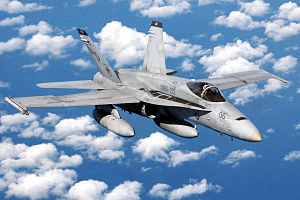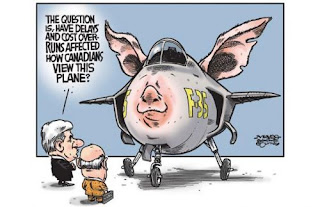 |
| It takes a lot of money to get the F-35 airborne... |
Elsewhere, the F-35 is being scrutinized as well, as the entire project is 10 years behind schedule and 1/2 a trillion (not a typo) dollars over budget.
So why is the F-35 so expensive anyway?
 |
| (Not so) Humble beginning: The X-35 JSF prototype. |
Looking back, it seems like an impossible project. To develop a single airframe capable of of replacing three different aircraft. If that wasn't hard enough, it was decided that the JSF would replace the F-117 stealth fighter as well as the A-10 Counter Insurgency (CoIn) aircraft as well. The reasoning behind this was that it would ultimately be cheaper to build one Jack-of-all-trades rather than several specialists.
 |
| Build us a low-cost multi-role fighter... |
 |
| Invisible to radar... |
 |
| That can land on a aircraft carrier... |
 |
| Provide low-level troop support... |
 |
| And take off and land vertically! |
Eventually, Lockheed Martin won out. It's X-35 prototype handled itself quite well in testing. Lockheed itself had shown it could handle bleeding edge designs with legendary aircraft such as the SR-71 Blackbird and F-22 Raptor, as well as pumping out reliable workhorses like the C-130 Hercules and P-3 Orion.
So what happened?
 |
| What happens when you keep adding stuff. |
It simply wasn't a matter of taking the X-35's blueprints and starting up large-scale production. The X-35 was missing two very important fighter components; a weapon system and avionics. The since weapons need to be carried internally on a stealth aircraft, the entire airframe needed changes. Weapons tests need to be done to ensure that a weapon bay door can open, launch a weapon, then close without problem.
The F-35's avionics have proven to be another factor. Using even more advanced systems than the F-22 Raptor, the F-35 computers need to be programmed with 8 million lines of code.
There is also the rather unfortunate fact that the F-35C carrier variant has yet to successfully land on even a simulated carrier due to a faulty tailhook design. This will of course, require further trips back to the drawing board followed by more testing.
In an odd move, the decision was made to start production of the F-35 without full flight testing. This practice, known as concurrency, speeds up acquisition, but requires early production aircraft to be modified as flight testing reveals problems. Imagine buying a car, but you need to bring it back to the dealer every few weeks for a year before it can be considered drivable on public roads.
So why is the F-35 program progressing when it is faced with so many problems? Momentum.
 |
| Who wants to be the politician to tell all these people to find new jobs? |
When the U.S. government realized it didn't really have the need nor the funds to keep building the expensive F-22... It kept building them. Why? Because F-22 production had been dispersed throughout the USA. Cutting F-22 production meant cutting high paying jobs. Any senator voting against F-22 production would have to face more than a few angry constituants. F-22 production kept going long after it was almost universally agreed to end it. Eventually, a total of 195 F-22s were built out of the original 750 planned.
Like the F-22, F-35 production is spread out. Unlike the F-22, production isn't merely limited to the U.S. Components for the F-35 are built in America, Canada, Britain, Italy, the Netherlands, Israel, Australia, Denmark, Singapore, and Norway. With a planned production run close to 2500 aircraft, any country leaving the program risks losing a lot of jobs.
Or do they?
Being a member of the F-35 project simply allows a country's business to bid on F-35 related contracts. There is no guarantee. It is entirely possible for Canada to spend $46 billion dollars on F-35 procurement only to receive a fraction of that money back in jobs created. Indeed, with the U.S. economy still suffering, the political pressure will be on for Lockheed to keep F-35 jobs in America.
Other countries are having second thoughts about their purchases as well. It is feared that, if any country cancels its order, the unit cost of these aircraft will go up, resulting in more cancelled orders, provoking a "death spiral" that simply pushes the plane out of the realm of affordability.
How desperate is the U.S. and Lockheed to keep F-35 sales? Desperate enough to deny a U.S. built AESA radar to the Saab Gripen that was competing for a Norway fighter bid. Rather than let the F-35 be judged on its own merits, it was deemed appropriate to hobble the competition. Since then, Saab has found different radar provider.
The question remains, will the current Canadian government be the first jump off the sinking ship that is the F-35? Or will it remain in the hopes of getting Canada some of those big money contracts being dangled like the proverbial carrot on a stick? Time is running out.

No comments:
Post a Comment